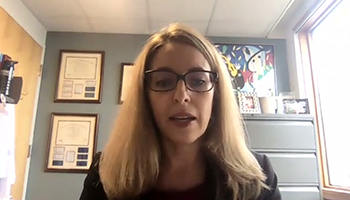
This article is part of Harvard Medical School’s continuing coverage of medicine, biomedical research, medical education, and policy related to the SARS-CoV-2 pandemic and the disease COVID-19.
Are children really spared the worst effects of COVID-19?
What’s the likelihood that an expectant or new mother will pass SARS-CoV-2—or antibodies that protect against it—to her fetus through the placenta or to her infant through breastfeeding?
Are COVID-19 vaccines as safe and effective for children as they are for adults? What about vaccination during pregnancy or breastfeeding?
Now that vaccines, along with mask wearing, physical distancing, and other precautions, are slashing the number of older adults in the U.S. who are hospitalized with or die from COVID-19, physicians and scientists are peering deeper into how SARS-CoV-2 infection and prevention affect special populations—including pregnant women, infants, and children.
Researchers in the Harvard Medical School community shared some of the latest findings on the maternal, fetal, and pediatric aspects of COVID-19 in an April 29 virtual public briefing, “COVID-19 in Pregnancy and Childhood.”
The event marked the latest in a yearlong series organized by the Massachusetts Consortium on Pathogen Readiness, or MassCPR, a multi-institutional group formed in March 2020 to address the current pandemic and prepare for future ones.
COVID-19 and pregnancy
Early in the pandemic, it became clear that pregnancy raises the risk of serious illness or death in those with COVID-19. Experts have also been concerned about the short- and long-term health consequences for infants born to mothers infected with SARS-CoV-2 while pregnant.
“As obstetricians, we worry about the mother and we worry about the developing fetus,” said Andrea Edlow, HMS assistant professor of obstetrics, gynecology and reproductive biology at Massachusetts General Hospital.
To transform that worry into knowledge that can spur action, Edlow and others have been examining the effects of SARS-CoV-2 on maternal and fetal health during pregnancy.

Recent research indicates that pregnant patients with COVID-19 are substantially more likely to be admitted to intensive care units, to need invasive ventilation or heart-lung bypass machines, and to die than those of the same age who are not pregnant, Edlow said. She noted that the difference is concerning even though the absolute risk for poor outcomes remains small—about 1.5 in 1,000 pregnant women with COVID-19.
The better news, she said, is that maternal-fetal transmission of SARS-CoV-2 is rare. Meta-analyses estimate that the virus crosses the placenta in only 7 percent of cases. Another piece of good news: So far, there have been no reported cases of so-called vertical transmission—in which the virus passes from mother to fetus across the placenta or from mother to infant through direct contact or in breast milk—in a cohort at three Harvard-affiliated hospitals, Edlow added.
A recent study from four HMS-affiliated hospitals adds more detail to the picture, reporting that newborns are five times more likely to get SARS-CoV-2 from infected mothers if the mother belongs to a “socially vulnerable” group.
Edlow described a surprising study she was involved in that showed that antibodies that fight the virus also have a hard time crossing the placenta. While antibodies against the viruses that cause the flu and whooping cough are known to rise over time in umbilical cord blood when expectant mothers become infected, antibodies against SARS-CoV-2 appear to transfer at a lower rate and to fall over time.
This suggests that the immune protections mothers gain after natural SARS-CoV-2 infection aren’t fully passed on to their infants, Edlow said. She and colleagues are exploring whether unusual patterns of sugar molecule attachment to the antibodies are to blame and could be altered to improve fetal protection.
COVID-19 vaccines in pregnancy
Early results suggest that getting a COVID-19 vaccine while pregnant or lactating is safe for the mother and fetus or infant; protective for the mother; and at least partially protective for the fetus or infant, reported Kathryn Gray, HMS assistant professor of obstetrics, gynecology and reproductive biology at Brigham and Women’s Hospital.

An ongoing study of pregnant, lactating, and non-pregnant participants at Mass General and Brigham and Women’s has found no significant differences in vaccine side effects across groups, and an external study has found no rise in miscarriage or preterm birth rates among vaccinated pregnant women compared with rates seen in pregnant women before the pandemic, Gray reported.
Further, study leaders have detected vaccine-induced antibodies in the cord blood and breast milk of mothers vaccinated during pregnancy, providing hope that some of the benefits of vaccination are being passed along, Gray said.
“There is a suggestion that infants will have some protection by maternal vaccination, but exactly what degree of protection remains a subject of ongoing study,” she said.
These and other studies have led the CDC to recommend COVID-19 vaccination during pregnancy, she said.
COVID-19 vaccines in childhood
Such research is beginning to address “many unanswered questions about vaccines in pregnant women and children since they were not included in initial clinical trials,” said briefing moderator and MassCPR member Howard Heller, assistant professor of medicine, part-time, at Massachusetts General Hospital.
Research is growing for the pediatric population. Ofer Levy, HMS professor of pediatrics and director of the Precision Vaccines Program at Boston Children’s Hospital, highlighted new trials by Pfizer, Moderna, and Johnson & Johnson exploring the safety, efficacy, and ideal dosage levels for COVID-19 vaccines in participants ranging from six months to 17 years old.
Although the final data have not yet been reported and analyzed, early indicators are encouraging, and it’s possible that good results could lead to emergency authorization as soon as this summer—a scenario that could mean vaccine availability for children before the new school year, said Levy, who is a member of the FDA Vaccines and Related Biological Products Advisory Committee. Levy emphasized that the reports are preliminary and that his remarks represented his personal opinion and were not made in his official capacity.
Even if that proves too optimistic a timeline, “I believe it’s possible to have schools open” safely in fall 2021 if teachers have access to vaccines and CDC guidance is followed, he said.

Levy also reported on his lab’s latest efforts to tailor SARS-CoV-2 vaccines for infants and children, among other vulnerable populations.
Levy and collaborators are collecting maternal blood and cord blood samples and using advanced technologies to model the immune system’s response to the vaccines. The goal is to quickly develop precision vaccines that optimize protection for the young.
Vaccines are effective only if people receive them, Levy pointed out. He cited a Pediatrics article [PDF] he co-authored with renowned vaccinologist Stanley Plotkin that enumerates 10 reasons to eventually make COVID-19 vaccination mandatory for U.S. children.
“Other than clean drinking water, vaccines are the most important biomedical intervention known to humans,” Levy said.
“If we’re going to get out of this mess, we need a pediatric component” to vaccine and public health strategies, he said.
When children get infected
It became clear a few months into the pandemic that while children don’t get as sick as older people on average, they still can spread the virus and, in some cases, fall seriously ill with unknown long-term health consequences.
Adrienne Randolph, HMS professor of anaesthesia and of pediatrics at Boston Children’s and principal investigator of a nationwide study of COVID-19 in young people, shared the latest knowledge about the disease in children and adolescents.
Randolph described what she and colleagues have learned about the worrisome multisystem inflammatory syndrome in children, or MIS-C, a rare complication of COVID-19 that affects multiple organs, often including the heart. Nearly 80 percent of children with MIS-C require ICU admission.
MIS-C appears to be a post-infection syndrome rather than an acute form of COVID-19, Randolph said. She and colleagues have found that many children with the syndrome have underlying immune dysregulation. The team is identifying potential genes that contribute to MIS-C risk.

Risks may also include socioeconomic or environmental factors. That would help explain why Hispanic/Latino and Black children are overrepresented, accounting for about 50 percent of MIS-C cases, she said.
Researchers still need to understand why children aren’t as vulnerable to COVID-19 as they are to respiratory viruses like the flu; what the long-term outcomes are of mild or severe COVID-19 during infancy, childhood, and early adulthood; and what treatments can help, said Randolph.
As more adults get vaccinated, Randolph said, children are making up a greater proportion of COVID-19 patients. That’s of concern both for the children themselves and for the general population if SARS-CoV-2 strains mutate into more dangerous forms as they circulate among unprotected children, she said.
The true goals of pediatric medicine and the unknown toll on children’s health shouldn’t get lost in the tumult of the pandemic, she said
“With the flu, we get alarmed if kids are hospitalized,” said Randolph. “Let’s go back to the normal world where it’s not just about keeping [kids with COVID-19] out of the ICU or avoiding neurological involvement—we don’t want them getting hospitalized at all. We don’t want any complications at all. We want to prevent that with vaccination.”


